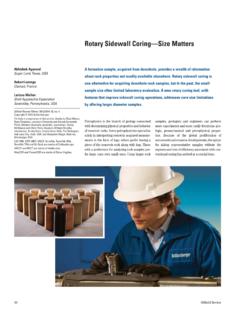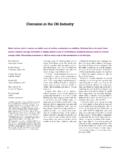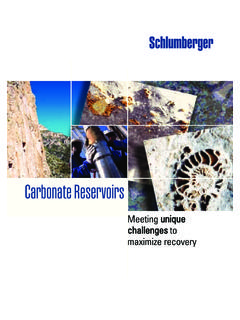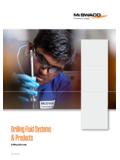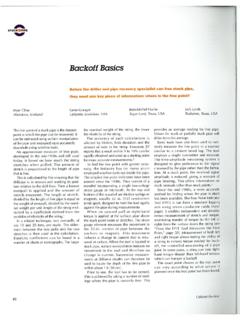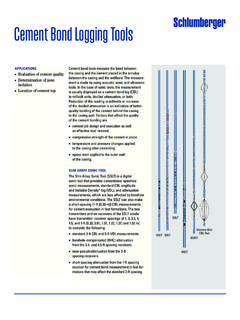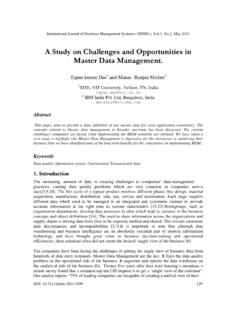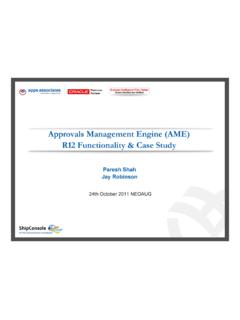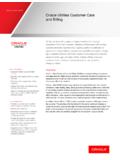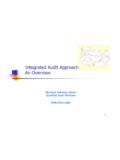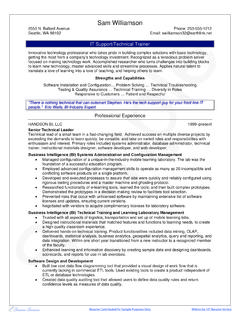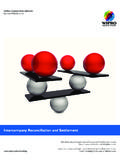Transcription of Managing Oilfield Data Management - …
1 32 Oilfield ReviewAs oil companies push for greater efficiency, many are revising howthey manage exploration and production (E&P) data . On the way out isproprietary software that ran the corporate data base on a mainframe,and on the rise is third-party software operating on a networked com-puting system. Computing standards are making practical the sharing ofdata by diverse platforms. Here is a look at how these changes affectthe geoscientist s Oilfield data ManagementToday s exploration and production geosci-entist works in a world of untidy , logs, seismic sections and well testreports may be scattered on isolated com-puters. They may exist only as tapes orpaper copies filed in a library in Dubai orstuffed in cardboard boxes in Anchorage(next page).
2 Often, most of the battle is sim-ply locating pertinent data arefound, the user may need to be multilingual,fluent in UNIX, VMS, DB2, SQL, DLIS andseveral dialects of , even whendata are loaded onto workstations, twointerpretation packages may be unable toshare information if they understand datadifferently one may define depth as truevertical depth, and another as measureddepth. The main concern for the geoscien-tist is not only: Where and in what form arethe data ? but also: Once I find what I need,how much time must I spend working onthe data before I can work with the data ?Despite this picture of disarray, E&P dataare easier to work on now than they werejust a few years ago, freeing more time towork with them.
3 Better tools are in place toorganize, access and share data . data orga-nization is improving through more flexibledatabase Management software a kind oflibrarian that finds and sometimes retrievesrelevant data , regardless of their form andlocation. Access to data is widening throughlinkage of data bases with networks thatunite offices, regions and opposite sides ofthe globe. And sharing of data by softwareof different disciplines and vendors, whilenot effortless, has become practical. It willbecome easier as the geoscience commu-nity inches closer to standards for how dataare defined, formatted, stored and Management the tools and organi-zation for orderly control of data , fromacquisition and input through validation,processing, interpretation and storage isgoing through changes far-reaching andpainful.
4 This article highlights two kinds ofchanges affecting data Management : physi-cal, the tools used for Managing data ; andconceptual, ideas about how data , datausers and tools should be organized. To understand where E&P data manage-ment is going, look at where it has comefrom. Today as much as 75% of geosciencedata are still stored as , the direc-tion of data Management is determined bythe 25% of data that are BaloughVastar ResourcesHouston, Texas, USAP eter BettsShell Internationale Petroleum Maatschappij BVThe Hague, The NetherlandsJack BreigBruno KarcherPetrotechnical Open Software CorporationHouston, TexasAndr ErlichCorte Madera, California, USAJim GreenUnocalSugar Land, TexasPaul HainesKen LandgrenRich MarsdenDwight SmithHouston, TexasJohn PohlmanPohlman & Associates, , TexasWade ShieldsMobil Exploration and Producing Technical CenterDallas, TexasLaramie WinczewskiFourth Wave Group, , Texas33 July 1994nThe incredible shrinking data store.
5 Log data from a single well have beentransferred from tapes and papercopies in a cardboard box to a 4-mmdigital audio tape (DAT), being passedfrom Karel Grubb, seated, to Mike Wille,both of GeoQuest. This cardboard datastore was among 2000 for a project inAlaska, USA. Logs from all 2000 wellswere loaded onto 18 DATs for off-sitestorage provided by the LogSAFE dataarchive service (page 40). One DAT canhold gigabytes, equivalent to con-ventional logs from about 100 Taylor BW: Cataloging: The First Step to data Man-agement, paper SPE 24440, presented at the SeventhSPE Petroleum Computer Conference, Houston, Texas,USA, July 19-22, UNIX and VMS are operating systems; DB2 is adatabase Management system for IBM mainframes;SQL is a language for querying relational data bases;and DLIS and SEG-Y are data Landgren K: data Management Eases IntegratedE&P, Euroil (June 1993): 31-32.
6 In this article Charisma, Finder, GeoFrame, IES (IntegratedExploration System), LogDB, LOGNET, LogSAFE andSmartMap are marks of Schlumberger; IBM and AIX aremarks of International Business Machines Corp.; Lotus 1-2-3 is a mark of Lotus Development Corp.; Macintosh is amark of Apple Computer Inc.; VAX and VMS are marks ofDigital Equipment Corp.; MOTIF is a mark of the OpenSoftware Foundation, Inc.; PetroWorks, SeisWorks, Strat-Works, SyntheSeis, and Z-MAP Plusare marks of Land-mark Graphics Corp.; GeoGraphix is a mark ofGeoGraphix, Inc.; ORACLE is a mark of Oracle Corpora-tion; POSC is a mark of the Petrotechnical Open SoftwareCorporation; Stratlog is a mark of Sierra Geophysics, Inc.;Sun and Sun/OS are marks of Sun Microsystems, Inc.
7 ;UNIX is a mark of AT&T; and X Window System is a markof the Massachusetts Institute of help in preparation of this article, thanks to NajibAbusalbi, Jim Barnett, Scott Guthery and Bill Quinlivan,Schlumberger Austin Systems Center, Austin, Texas, USA;Bill Allaway, GeoQuest, Corte Madera, California, USA;Richard Ameen, Bobbie Ireland, Jan-Erik Johansson,Frank Marrone, Jon Miller, Howard Neal, Mario Rosso,Terry Sheehy, Mike Wille and Beth Wilson, GeoQuest,Houston, Texas; Bob Born, Unocal, Sugar Land, Texas,USA; Ian Bryant, Susan Herron, Karyn Muller and RaghuRamamoorthy, Schlumberger-Doll Research, Ridgefield,Connecticut, USA; Alain Citerne and Jean Marc Soler,Schlumberger Wireline & Testing, Montrouge, France;Peter Day, Unocal Energy Resources Division, Brea, Cal-ifornia; Mel Huszti, Public Petroleum data Model Asso-ciation, Calgary, Alberta, Canada; Craig Hall, SteveKoinm, Kola Olayiwola and Keith Strandtman, VastarResources, Inc.
8 , Houston, Texas; Stewart McAdoo,Geoshare User Group, Houston, Texas; Bill Prins,Schlumberger Wireline & Testing, The Hague, TheNetherlands; Mike Rosenmayer, GeoQuest, Sedalia, Colorado, backgrounds. Interpretation anddata Management software evolves rapidlyand tends to be from vendors rather thanhome grown. Sometimes the network con-nects to the mainframes, which are reservedfor data archiving or for a master data base(more about this later). Mainframes are alsoreemerging in the new role of superservers, controlling increasingly complexnetwork one degree or another, all four genera-tions often still coexist in oil companies, butmost companies are moving rapidly towardnetworked shift to newtechnology and, recently, to technologythat is bought rather than built in-house ischanging the physical and conceptualshapes of data Management .
9 Since about1990 two key trends have emerged: The monolithic data store is beingreplaced, or augmented, with three levelsof flexible data storage. A single corporatedata store8used to feed isolated islands ofUseful abstractionsThe complexity and volume of information man-aged by the E&P industry is overwhelming. Thisis a serious impediment to information exchange,especially where information is generated by pro-fessionals in dissimilar business functions. Thesuccessful data model reveals to the user theplaces of similarity in information capability provides business opportunitiesboth for users, in accessing data from unexpectedsources, and for application developers to targetnew, but semantically similar, business information coverageA successful data model captures all kinds ofinformation used in the E&P business, as well assufficient semantics about the meaning of data ,to ensure that it can be used correctly by diverseapplications and users, in both planned andunplanned ways.
10 In other words, a semanticallyrich data model optimizes the sharing of dataacross different disciplines. data Management can increasingly becalled computer or digital data manage-ment, and its development therefore paral-lels that of information technology (right). Inthe last 30 years, information technologyhas passed through four stages through a geosciencelens, they are:First generation: Back-room in specially built rooms ranbatch jobs overseen by computer time was a few hours or processing was highly bureaucratic,overseen by computer scientists using datasupplied by geoscientists. The highly securecentral repository of data , called the corpo-rate data base, resided here.

